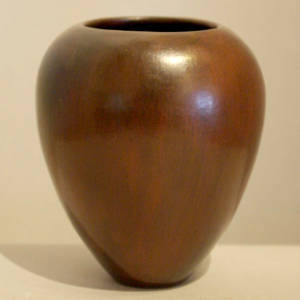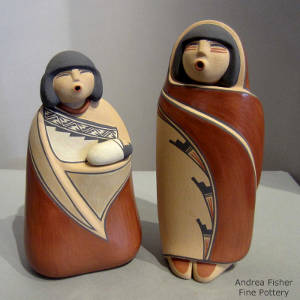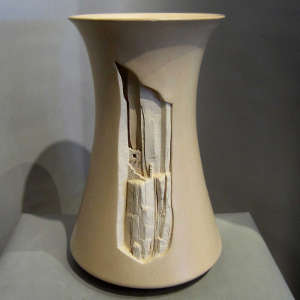Design Elements: Burnishing
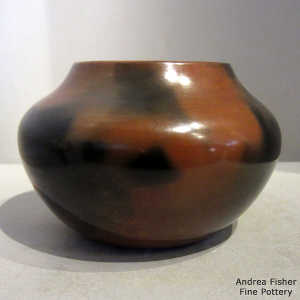
Burnished brown jar with fire cloluds and pine pitch coating,
by Susie Crank, Diné
4.25 in H by 6.25 in Dia
Alice Cling is Rose Williams' oldest daughter. She grew up working with Diné clay as she helped her mother create her trademark cylinders and drums. On her own, Alice makes much smaller pieces, so as not to compete in the market with her mother. Alice's work has won numerous awards in big competitions but she doesn't usually burnish a piece once she has applied the (nearly) obligatory coating of pine pitch.
Alice Cling's younger sister, Susie Crank, also learned to make Diné pottery from their mother, Rose Williams. As a younger sister, Susie doesn't want to compete with Alice in the marketplace so she hasn't earned as big a name for herself. However, after polishing her pieces, firing them and coating them with pine pitch, Susie almost always takes the added step of burnishing that final coating of pitch and her pieces are finished with a softer look to them.
Most clay in Jemez country has a bit of a sandy texture to it, so burnishing surfaces takes a fair bit more effort. Maxine Toya takes that into account and uses the deeper reds of her finished burnished surfaces to complement her creations while using unburnished surfaces for painting designs on.
Being an engineer, Al Qoyawayma is very familiar with his clay. He likes to polish his pieces with a river stone and some watered down slip, then he burnishes them with the river stone to make the inevitable background strokes run in the same direction. After that he carves and sculpts and sometimes paints his pieces before firing them.
The potters of Mata Ortiz spent maybe 10 years developing a method for always getting a glossy black finish on their pieces. The final recipe requires the piece be coated several times with a manganese oxide slip, each coat allowed to dry. It usually takes 4 coats to get enough on the clay to hold the graphite once it's applied. Then comes a slip composed of 5% baby lotion, 5% black graphite and 90% kerosene. Coat the piece and let it dry. Then burnish softly and repeat, 3 or 4 more times. The burnishing is required to get that final glossy finish. Then some artists paint birds, dragonflies, fish and geometric designs on that before firing the piece.
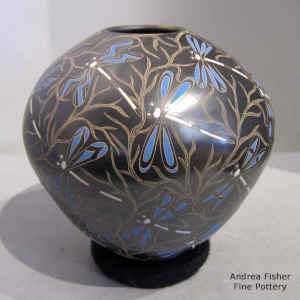
Polychrome black-graphite jar decorated with a sgraffito and painted dragonfly and branch design, by Elicena Cota, Mata Ortiz
6 in H by 6 in Dia
Measurement includes stand
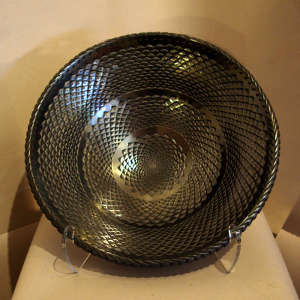
Large graphite black bowl carved with a basket weave design, by Mauro Quezada, Mata Ortiz
4.5 in H by 16 in Dia
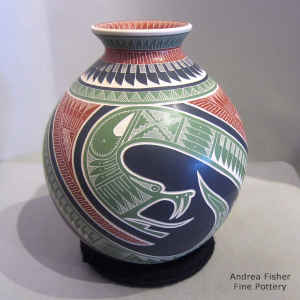
Polychrome black graphite jar decorated with a lightly carved, sgraffito and painted serpent and geometric design, by Eduardo Olivas, Mata Ortiz
7.75 in H by 6.5 in Dia
Measurement includes stand
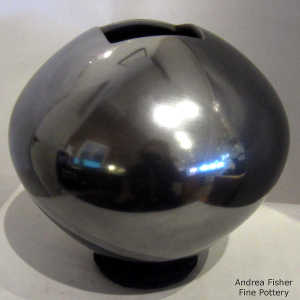
A square opening on a plain, polished black graphite jar, by Reuben Lucero, Mata Ortiz
9 in H by 9.75 in Dia
Measurement includes stand
